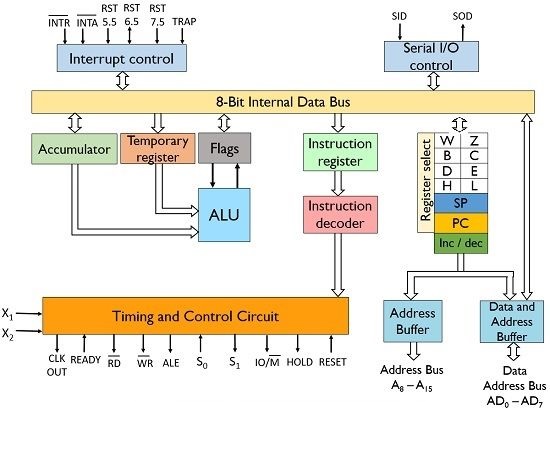Intel 8085 Microprocessor - Pin Configuration - Concise Notes For Exams
The pins of a 8085 microprocessor are classified into seven groups.
Address Bus :
A15-A8, it carries the most significant 8-bits of memory/IO address.
Data Bus :
AD7-AD0, it carries the least significant 8-bit address and data bus.
Control and Status Signals :
These signals are used to identify the nature of operation. There are 2control signal and 3 status signals.
Two control signals are RD, WR
RD − This signal indicates that the selected IO or memory device is to be read and is ready for accepting data available on the data bus.
WR − This signal indicates that the data on the data bus is to be written into a selected memory or IO location.
Three status signals are IO/M, S0 and S1.
IO/M
This signal is used to differentiate between IO and Memory operations, i.e. when it is high indicates IO operation and when it is low then it indicates memory operation.
S1 and S0
These signals are used to identify the type of current operation.
Power Supply :
There are 2 power supply signals − VCC & VSS. VCC indicates +5v power supply and VSS indicates ground signal.
Clock Signals :
There are 3 clock signals, i.e. X1, X2, CLK OUT.
X1, X2 − A crystal (RC, LC N/W) is connected at these two pins and is used to set frequency of the internal clock generator. This frequency is internally divided by 2.
CLK OUT − This signal is used as the system clock for devices connected with the microprocessor.
Interrupts :
Interrupts are the signals generated by external devices to request the microprocessor to perform a task. There are 5 interrupt signals, i.e. TRAP, RST 7.5, RST 6.5, RST 5.5, and INTR. We will discuss interrupts in detail in interrupts section.
INTA − It is an interrupt acknowledgment signal.
RESET IN − This signal is used to reset the microprocessor by setting the program counter to zero.
RESET OUT − This signal is used to reset all the connected devices when the microprocessor is reset.
READY − This signal indicates that the device is ready to send or receive data. If READY is low, then the CPU has to wait for READY to go high.
HOLD − This signal indicates that another master is requesting the use of the address and data buses.
HLDA (HOLD Acknowledge) − It indicates that the CPU has received the HOLD request and it will relinquish the bus in the next clock cycle. HLDA is set to low after the HOLD signal is removed.
Serial I/O Signals :
There are 2 serial signals, i.e. SID and SOD and these signals are used for serial communication.
SOD (Serial output data line) − The output SOD is set/reset as specified by the SIM instruction.
SID (Serial input data line) − The data on this line is loaded into accumulator whenever a RIM instruction is executed.
Intel 8085 Microprocessor - Internal Architecture - Concise Notes For Exams
Intel 8085 is an 8-bit microprocessor with a capacity to address 216 memory locations - 64 KB. It can perform 8-bit operations at a time. It needs a single 5 V power supply with a clock running at a frequency ~3 MHz .
Architecture of 8085 Microprocessor:
General Purpose Registers are a set of registers which are located inside the 8085 microprocessor. They can store and process 8 bit data. These registers are B,C,D,E,H and L. They can be combined to form pairs BC,DE and HL in order to enable the execution of 16-bit operations.
General purpose registers are accessible to the programmer through the 8085 instruction set. They are used to insert and transfer data.
Temporary Registers :
These registers are used by the ALU to store the data on temporary basis and these are not accessed by the programmer. These are of 2 types:
- Temporary data register – It is an 8-bit register that holds the operand and provides it to the ALU for program execution. Also, the immediate results are stored by the ALU in this register.
- W and Z register – These registers are also used to hold the temporary values. It is used by the control section of the microprocessor so as to store the data during operations.











